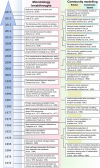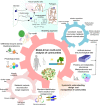Elucidation of complexity and prediction of interactions in microbial communities
- PMID: 28925555
- PMCID: PMC5658597
- DOI: 10.1111/1751-7915.12855
Elucidation of complexity and prediction of interactions in microbial communities
Abstract
Microorganisms engage in complex interactions with other members of the microbial community, higher organisms as well as their environment. However, determining the exact nature of these interactions can be challenging due to the large number of members in these communities and the manifold of interactions they can engage in. Various omic data, such as 16S rRNA gene sequencing, shotgun metagenomics, metatranscriptomics, metaproteomics and metabolomics, have been deployed to unravel the community structure, interactions and resulting community dynamics in situ. Interpretation of these multi-omic data often requires advanced computational methods. Modelling approaches are powerful tools to integrate, contextualize and interpret experimental data, thus shedding light on the underlying processes shaping the microbiome. Here, we review current methods and approaches, both experimental and computational, to elucidate interactions in microbial communities and to predict their responses to perturbations.
© 2017 The Authors. Microbial Biotechnology published by John Wiley & Sons Ltd and Society for Applied Microbiology.
Figures




References
-
- Alhumazi, K. , and Ajbar, A. (2005) Dynamics of predator‐prey interactions in continuous cultures. Eng Life Sci 5: 139–147.
-
- Allison, S.M. , Small, J.R. , Kacser, H. , and Prosser, J.I. (1993) Control analysis of microbial interactions in continuous culture: a simulation study. J Gen Microbiol 139: 2309–2317.
-
- Andreote, F.D. and Pereira e Silva, M.C. (2017) Microbial communities associated with plants: learning from nature to apply it in agriculture. Curr Opin Microbiol 37: 29–34. - PubMed
Publication types
MeSH terms
Grants and funding
LinkOut - more resources
Full Text Sources
Other Literature Sources

